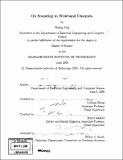On sounding in wideband channels
Author(s)
Jing, Sheng, Ph. D. Massachusetts Institute of Technology
DownloadFull printable version (2.903Mb)
Other Contributors
Massachusetts Institute of Technology. Dept. of Electrical Engineering and Computer Science.
Advisor
Lizhong Zheng.
Terms of use
Metadata
Show full item recordAbstract
(cont.) This approach provides us with a cohesive framework to consider the relative costs and benefits of allotting energy for sounding versus transmission, and for repeated sounding of a single channel versus sounding of various different channels. In particular, we are able to give both an upper bound and a lower bound on the number of subchannels that should be probed for capacity maximization in terms of the available transmission energy, the available bandwidth and the fading characteristics of the channel. Moreover, the two bounds are so close to each other that they may well be treated as an approximation to the desirable number of subchannels to probe. For an average-power-constrained wideband fading channel, on the one hand, if the transmitter has perfect knowledge of the fading state over the entire spectrum, the maximum achievable rate (Capacity) is infinite; on the other hand, if the transmitter has no knowledge of the channel's fading state, the capacity is finite. Therefore, the transmitter's knowledge of channel fading states has a great impact on the channel capacity. However, in the low SNR scenario, the energy per degree of freedom does not suffice to provide an accurate measurement of the channel over the entire spectrum in wideband channels. In the presence of feedback, we may garner information at the transmitter about some aspects of the channel quality over certain portion of the spectrum. In this work, we investigate a scheme to capture the effect of such information. We consider channel sounding with a finite amount of energy over a block-fading channel in both time and frequency. The quality of each subchannel is assessed as being the crossover probability in a BSC. In order to characterize a judicious policy for allocating energy to different subchannels in view of establishing their usefulness for transmission, we use a multi-armed bandit approach.
Description
Includes bibliographical references (leaves 75-76). Thesis (S.M.)--Massachusetts Institute of Technology, Dept. of Electrical Engineering and Computer Science, 2006.
Date issued
2006Department
Massachusetts Institute of Technology. Department of Electrical Engineering and Computer SciencePublisher
Massachusetts Institute of Technology
Keywords
Electrical Engineering and Computer Science.